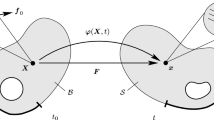Abstract
In the present paper 3D rate sensitive constitutive model for modeling of laminate composites is presented. The model is formulated within the framework of continuum mechanics based on the principles of irreversible thermodynamics. The matrix (polyester resin) is modeled by employing a 3D rate sensitive microplane model. For modeling of fibers (glass) a uni-axial constitutive law is used. The fibers are assumed to be uniformly smeared-out over the matrix. The formulation is based on the assumption of strain compatibility between matrix and fibers. Total stress tensor is additively decomposed into the contribution of matrix and fibers, respectively. To model de-lamination of fibers, the matrix is represented by periodically distributed initial imperfection over the pre-defined bands, which are parallel to fibers. Physically, this assumption accounts for the matrix-fiber interface in a smeared way. The input parameters of the model are defined by the mechanical properties of matrix and fibers (elastic properties, strength and fracture energy), the volume fraction of fibers and by their spatial orientation. The model is implemented into a 3D finite element code. To assure mesh objective results crack band method is employed. The model is first calibrated using a few basic test results. Subsequently, the model is validated with several numerical examples for specimens loaded in uni-axial tension, uni-axial compression and shear. Comparison between numerical and test results shows that the proposed model is able to predict the resistance and failure mode of complex fiber-reinforced composite for different orientation of fibers and different loading conditions with sufficient accuracy. Finally, based on the qualitative type of the finite element analysis, it is demonstrated that the strain rate dependency becomes more important when the angle between the fiber and load direction increases.
Similar content being viewed by others
References
Azzi VD, Tsai SW (1965) Anisotropic strength of composites. J Exp Mech 5(3): 283–288
Bažant ZP, Oh BH (1983) Crack band theory for fracture of concrete. RILEM 93(16): 155–177
Bažant ZP, Caner FC, Adley MD, Akers SA (2000) Fracturing rate effect and creep in microplane model for dynamics. J Eng Mech ASCE 126(9): 962–970
Belytschko T, Liu WK, Moran M (2001) Nonlinear finite elements for continua and structures. Wiley, London
Berthelot JM (1998) Composite materials: mechanical behavior and structural analysis, F.F. Ling (ed), Springer, Berlin
Carol I, Rizzi E, Willam K (2001) On the formulation of anisotropic elastic degradation. I. Theory based on a pseudo-logarithmic damage tensor rate. Int J Solid Struct 38(4): 491–518
Chang FK, Chang KY (1987) A progressive damage model for laminated composites containing stress concentrations. J Compos Mater 21: 834–835
Crisfield MA, Jelenić G, Mi Z, Zhong HG, Fan Z (1997) Some aspects of the non-linear finite element method. Finite Elem Anal Des 27: 19–40
Daniel IM, Ishai O (1994) Engineering mechanics of composite materials. Oxford University Press, Oxford. ISBN 0-19-5075506-4
Gol‘denblatt II, Kopnov VA (1966) Strenght of glass reinforced plastics. J Polym Mech 1(2): 54–59
Hashin Z (1980) Failure criteria for unidirectional fiber composites. J Appl Mech 47: 329–334
Hill R (1950) The mathematical theory of plasticity. Oxford University Press, Oxford, pp 313–349
Hill R (1990) Constitutive modelling of orthotropic plasticity in sheet metals. J Mech Phys Solids 3: 405–417
Hou JP, Petrinić N, Ruiz C (2001) A delamination criterion for laminated composites under low-velocity impact. Composites Sciences and Technology 61: 2069–2074
Hoffman O (1967) The Brittle Strength of Orthotropic Materials. J Compos Mater 1(2): 200–206
Jirásek M, Bažant ZP (2001) Inelastic analysis of structures. Wiley, London
Krausz AS, Krausz K (1988) Fracture kinetics of crack growth. Kluwer, Dordrecht
Lacković V (2009) Influence of the amount and structure of glass fibers on the mechanical properties of polymer composites. PhD. Thesis, University of Zagreb, Faculty of Civil Engineering Zagreb, Croatia (in Croatian)
Ladeveze P, Le Dantec E (1992) Damage modelling of the elementary ply for laminate composites. Compos Sci Technol 43: 257–267
Ožbolt J, Reinhardt HW (2001) Three-dimensional finite element model for creep-cracking interaction of concrete. In: Ulm B, Wittmann (eds) Proceedings of the sixth international conference CONCREEP-6, pp. 221–228
Ožbolt J, Li Y, Kožar I (2001) Microplane model for concrete with relaxed kinematic constraint. Int J Solid Struct 38: 2683–2711
Ožbolt J, Rah KK, Mestrović D (2006) Influence of loading rate on concrete cone failure. Int J Fract 139: 239–252
Travaš V, Ožbolt J, Kožar I (2009) Failure of plain concrete beam at impact load: 3D finite element analysis. Int J Fract 160(1): 31–41
Tsai SW, Wu EM (1971) A general theory of strength for anisotropic materials. J Compos Mater 5: 58–80
Author information
Authors and Affiliations
Corresponding author
Rights and permissions
About this article
Cite this article
Ožbolt, J., Lacković, V. & Krolo, J. Modeling fracture of fiber reinforced polymer. Int J Fract 170, 13–26 (2011). https://doi.org/10.1007/s10704-011-9598-6
Received:
Accepted:
Published:
Issue Date:
DOI: https://doi.org/10.1007/s10704-011-9598-6




